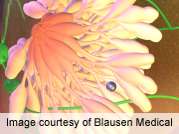(HealthDay)—Inclusion of endogenous hormones in prediction models improves prediction of invasive breast cancer risk in postmenopausal women, according to a study published online Aug. 18 in the Journal of Clinical Oncology.
Shelley S. Tworoger, Ph.D., from Brigham and Women's Hospital and Harvard Medical School in Boston, and colleagues examined whether inclusion of endogenous hormones would improve postmenopausal invasive breast cancer risk prediction. Improvement was assessed with inclusion of each of plasma estradiol, estrone, estrone sulfate, testosterone, dehydroepiandrosterone sulfate, prolactin, and sex hormone binding-globulin (SHBG) to the Gail and Rosner-Colditz risk scores in 437 patient cases and 775 controls not using postmenopausal hormones.
The researchers found that each hormone correlated with breast cancer risk (odds ratio doubling, 0.82 for SHBG to 1.37 for estrone sulfate). For the Gail and Rosner-Colditz scores, individual hormones improved the area under the curve (AUC) for five-year risk of invasive breast cancer by 1.3 to 5.2 units and 0.3 to 2.9 units, respectively. In stepwise regression, estrone sulfate, testosterone, and prolactin were selected and increased the AUC by 5.9 units (P = 0.003) for the Gail score and by 3.4 units (P = 0.04) for the Rosner-Colditz score. The average AUC change across the validation data sets was 6.0 (P = 0.002) and 3.0 units (P = 0.03), respectively.
"Our results support that endogenous hormones improve risk prediction for invasive breast cancer and could help identify women who may benefit from chemoprevention or more screening," the authors write.
More information:
Abstract
Full Text (subscription or payment may be required)
Journal information: Journal of Clinical Oncology
Copyright © 2014 HealthDay. All rights reserved.



















